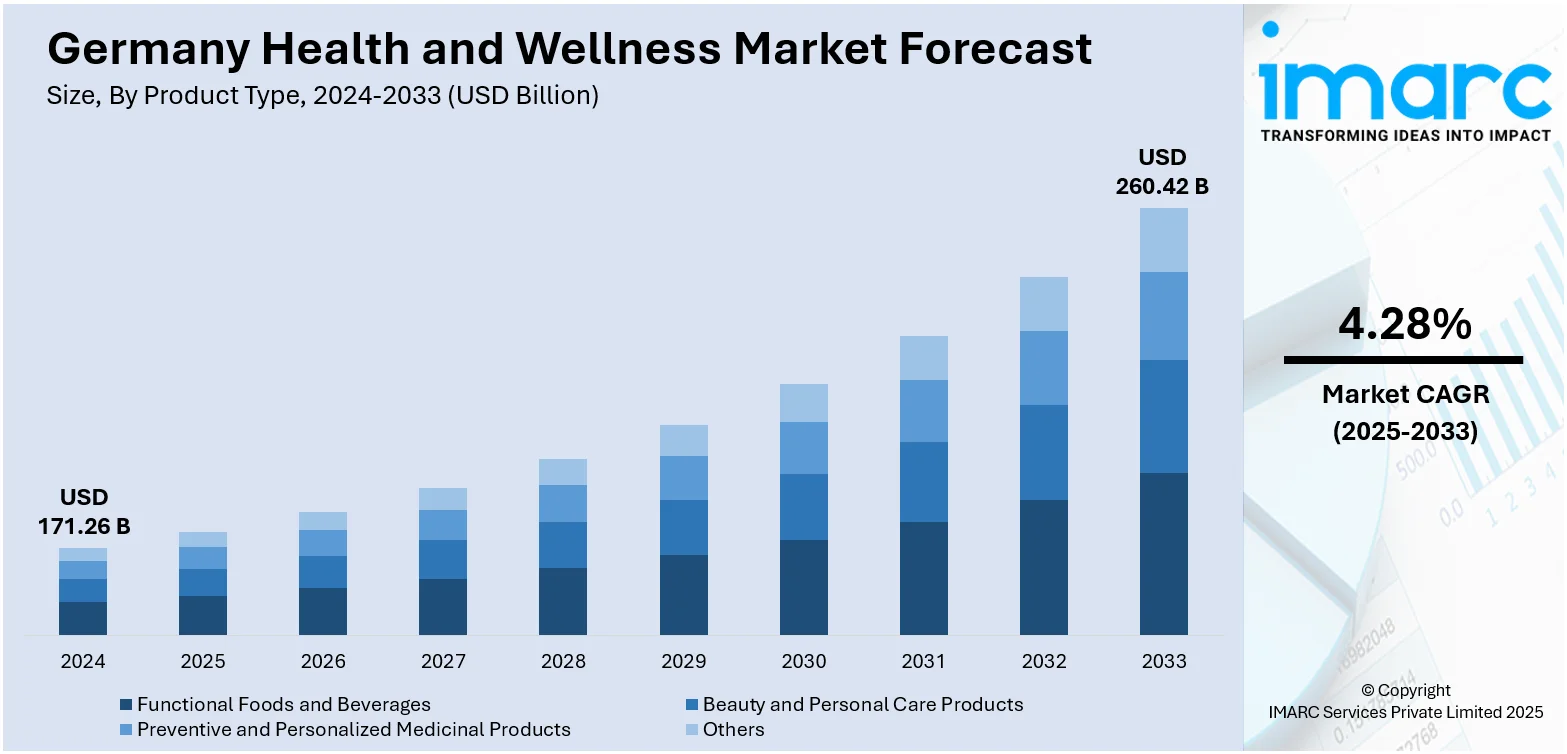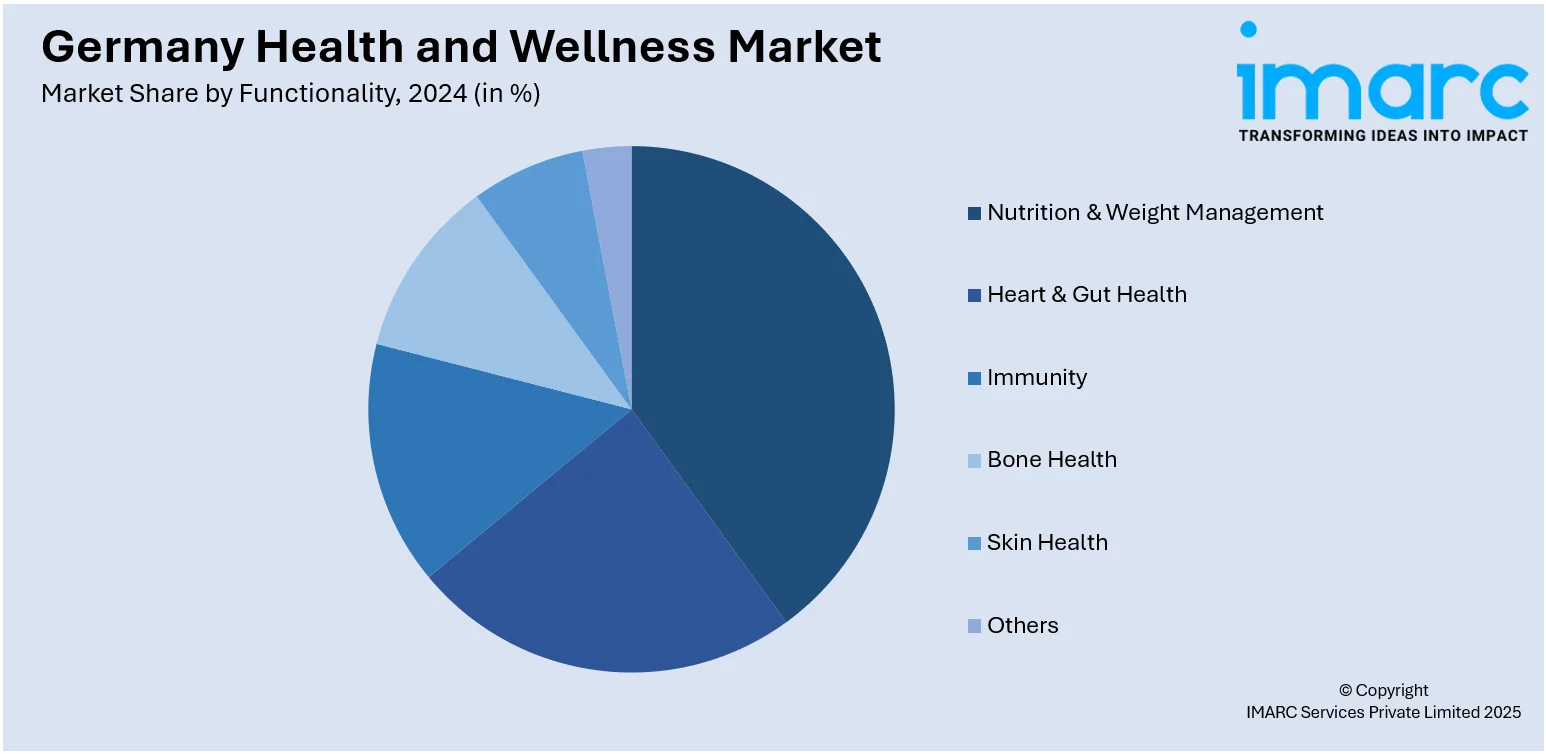
Germany Health and Wellness Market Size, Share, Trends and Forecast by Product Type, Functionality, and Region, 2025-2033
Germany Health and Wellness Market Overview:
The Germany health and wellness market size reached USD 171.26 Billion in 2024. Looking forward, the market is expected to reach USD 260.42 Billion by 2033, exhibiting a growth rate (CAGR) of 4.28% during 2025-2033. The market is characterized by rising consumer consciousness regarding preventive care, a robust ethos of natural and holistic healing, and expanding interest in organic, plant-based goods. Germany's focus on sustainability, mind health, and high-end healthcare infrastructure also enhances innovation in wellness services. Adoption of technology has become faster, facilitating customized health experiences. Government health programs encouraging active living and employer-sponsored wellness initiatives account for increasing participation among all age groups, which further contributes to the expansion of Germany health and wellness market share.
|
Report Attribute
|
Key Statistics
|
|---|---|
|
Base Year
|
2024
|
|
Forecast Years
|
2025-2033
|
|
Historical Years
|
2019-2024
|
| Market Size in 2024 | USD 171.26 Billion |
| Market Forecast in 2033 | USD 260.42 Billion |
| Market Growth Rate 2025-2033 | 4.28% |
Germany Health and Wellness Market Trends:
Green Wellness and Natural Health Practices
Germany has a long-standing tradition of embracing natural health and wellness, intensified by recent consumer shifts toward eco-friendly and holistic lifestyles. The “green wellness” movement emphasizes organic skincare, natural supplements, and plant-based medicines all regulated within Germany’s stringent health and safety framework. Interest in therapies such as hydrotherapy, forest therapy (Waldbaden), and Kneippism a 19th-century Bavarian therapy persists, especially in areas like the Black Forest, where wellness tourism is booming. They are now blended with contemporary wellness treatments, such as mineral baths and mindfulness retreats, and thus offer holistic packages that suit Germany's cultural sense. Consequently, customers are looking for preventative and nature-oriented wellness options that resonate with their environmental agendas, which further propels the Germany health and wellness market growth.

To get more information on this market, Request Sample
For instance, the Reformhaus cooperative, a reputable supporter of local health and beauty in retail, changed its business model in December 2024 as the nation got ready for the holiday shopping season in order to stay competitive in the face of discount stores, inflation pressures, and shifting consumer preferences. Originating from the 19th-century Lebensreform (life reform) movement that valued nature and opposed industrialization, Reformhaus stores operate independently as either single-owned shops or regional chains, yet they unite for centralized purchasing and marketing efforts. Lebensreform advocates established communities primarily in urban areas aiming to strengthen their bond with nature while rejecting the pollutants of industrialized society and traditional agriculture. The movement gave rise to vegetarianism, natural healing methods, naturism, anti-alcohol initiatives, and early environmental activism. Vegetarianism, natural health methods, naturism, the anti-drinking campaign, and early environmental activism were all branches of the movement.
Digital Fitness and Personalized Wellness Solutions
Germany's digital wellness and fitness market has been growing extremely fast, fueled by consumer aspirations for flexibility as well as customization. Mobile health apps that provide customized exercise plans, virtual classes, and wellness tracking platforms are becoming more and more popular, thanks to the nation's highly developed digital infrastructure and robust data protection legislation. Another emerging trend is the inclusion of wellness technologies like static fitness trackers, genetic analysis, and biometric feedback within personalized nutrition and fitness programs, which perfectly fits with Germany's proactive healthcare culture. This bespoke, technology-driven strategy is transforming the way Germans engage with self-care, shifting from cookie-cutter solutions to custom experiences meeting individual physiology, lifestyle, and health objectives.
Corporate and Mental Health Focus
Germany is also seeing an increasing integration of wellness into corporate and public health arenas. Firms are increasingly adopting workplace wellness programs that cover fitness, stress management, nutrition counseling, and smoking cessation spearheaded by a recognition of their influence on employee productivity and healthcare expenses. At the same time, there is a robust national emphasis on mental health normalization and availability. Teletherapy applications, conversational agents based on artificial intelligence, and mindfulness applications are becoming accepted both among providers and users and are assisting in combating stress and mental disease while lowering stigma. These advancements are connected to Germany's wider preventive care approach, where physical and mental health are intertwined, supported by policy, corporate action, and technical innovation.
Germany Health and Wellness Market Segmentation:
IMARC Group provides an analysis of the key trends in each segment of the market, along with forecasts at the country and regional levels for 2025-2033. Our report has categorized the market based on product type and functionality.
Product Type Insights:
- Functional Foods and Beverages
- Beauty and Personal Care Products
- Preventive and Personalized Medicinal Products
- Others
The report has provided a detailed breakup and analysis of the market based on the product type. This includes functional foods and beverages, beauty and personal care products, preventive and personalized medicinal products, and others.
Functionality Insights:

- Nutrition & Weight Management
- Heart & Gut Health
- Immunity
- Bone Health
- Skin Health
- Others
A detailed breakup and analysis of the market based on the functionality has also been provided in the report. This includes nutrition and weight management, heart & gut health, immunity, bone health, skin health, and others.
Regional Insights:
- Western Germany
- Southern Germany
- Eastern Germany
- Northern Germany
The report has also provided a comprehensive analysis of all the major regional markets, which include Western Germany, Southern Germany, Eastern Germany, and Northern Germany.
Competitive Landscape:
The market research report has also provided a comprehensive analysis of the competitive landscape. Competitive analysis such as market structure, key player positioning, top winning strategies, competitive dashboard, and company evaluation quadrant has been covered in the report. Also, detailed profiles of all major companies have been provided.
Germany Health and Wellness Market News:
- In November 2024, the German legislature enacted a law intended to restructure the healthcare system, reducing the number of hospitals, enhancing clinics, and modernizing administrative processes.
Germany Health and Wellness Market Report Coverage:
| Report Features | Details |
|---|---|
| Base Year of the Analysis | 2024 |
| Historical Period | 2019-2024 |
| Forecast Period | 2025-2033 |
| Units | Billion USD |
| Scope of the Report |
Exploration of Historical Trends and Market Outlook, Industry Catalysts and Challenges, Segment-Wise Historical and Future Market Assessment:
|
| Product Types Covered | Functional Foods and Beverages, Beauty and Personal Care Products, Preventive and Personalized Medicinal Products, Others |
| Functionalities Covered | Nutrition and Weight Management, Heart & Gut Health, Immunity, Bone Health, Skin Health, Others |
| Regions Covered | Western Germany, Southern Germany, Eastern Germany, Northern Germany |
| Customization Scope | 10% Free Customization |
| Post-Sale Analyst Support | 10-12 Weeks |
| Delivery Format | PDF and Excel through Email (We can also provide the editable version of the report in PPT/Word format on special request) |
Key Questions Answered in This Report:
- How has the Germany health and wellness market performed so far and how will it perform in the coming years?
- What is the breakup of the Germany health and wellness market on the basis of product type?
- What is the breakup of the Germany health and wellness market on the basis of functionality?
- What is the breakup of the Germany health and wellness market on the basis of region?
- What are the various stages in the value chain of the Germany health and wellness market?
- What are the key driving factors and challenges in the Germany health and wellness market?
- What is the structure of the Germany health and wellness market and who are the key players?
- What is the degree of competition in the Germany health and wellness market?
Key Benefits for Stakeholders:
- IMARC’s industry report offers a comprehensive quantitative analysis of various market segments, historical and current market trends, market forecasts, and dynamics of the Germany health and wellness market from 2019-2033.
- The research report provides the latest information on the market drivers, challenges, and opportunities in the Germany health and wellness market.
- Porter's five forces analysis assist stakeholders in assessing the impact of new entrants, competitive rivalry, supplier power, buyer power, and the threat of substitution. It helps stakeholders to analyze the level of competition within the Germany health and wellness industry and its attractiveness.
- Competitive landscape allows stakeholders to understand their competitive environment and provides an insight into the current positions of key players in the market.
Need more help?
- Speak to our experienced analysts for insights on the current market scenarios.
- Include additional segments and countries to customize the report as per your requirement.
- Gain an unparalleled competitive advantage in your domain by understanding how to utilize the report and positively impacting your operations and revenue.
- For further assistance, please connect with our analysts.
 Request Customization
Request Customization
 Speak to an Analyst
Speak to an Analyst
 Request Brochure
Request Brochure
 Inquire Before Buying
Inquire Before Buying




.webp)




.webp)












